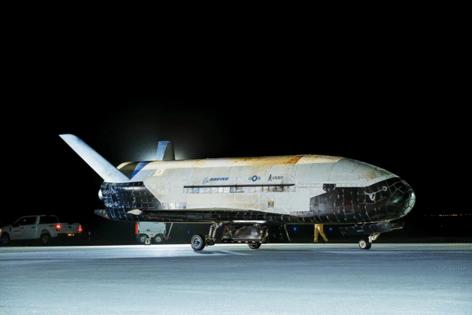Secretive mini space shuttle set for Space Coast launch; late-night sonic boom possible
Published in News & Features
It won’t have any crew, but the U.S. Space Force is set to send the Boeing-built X-37B spacecraft — which looks like a miniature space shuttle — back for a long-duration mission to orbit during a late-night launch Thursday.
A SpaceX Falcon 9 is set to lift off with the spacecraft on the USSF-36 mission from Kennedy Space Center’s Launch Pad 39-A targeting liftoff at 11:50 p.m. during a launch window that runs from runs until 5:11 a.m., according to the Federal Aviation Administration. A backup option is available during a window from 12-5:31 a.m. Saturday.
Space Launch Delta 45’s weather squadron forecasts a 65% chance for good conditions at the opening of the window, which improves to 80% by the end of it. Similar conditions are forecast if delayed 24 hours.
The first-stage booster is making its sixth trip to space and will aim for a recovery at Cape Canaveral Space Force Station’s Landing Zone 2, which means parts of Central Florida could be in store to hear one or more late-night sonic booms.
The spacecraft is designated an Orbital Test Vehicle and is about 29 feet long with a 14-foot wingspan. This is the second of two versions of the spacecraft that so far have combined to fly seven times since April 2010, spending more than 4,200 days in space.
In comparison, the space shuttle orbiters were 184 feet long with 78-foot wingspan. Boeing’s uncrewed spacecraft fits in normal rocket fairings, or nosecones, and has flown five times on United Launch Alliance Atlas V rockets, once on SpaceX Falcon 9 and once on Falcon Heavy.
The Space Force did not announce the planned duration for this mission, designated OTV-8, but OTV-7, which used the other of Boeing’s two spacecraft and launched in 2023 atop a Falcon Heavy, didn’t land until this past March spending more than 434 days in orbit. The last time this particular spacecraft flew, launching in 2020, it didn’t return to Earth until more than 908 days later.
The spacecraft has made landings both at the former Space Shuttle Landing Facility at KSC as well as in California at Vandenberg Space Force Base.
Just what the X-37B carries to orbit is mostly classified, but the Department of Defense states it uses the vehicle to test technologies for long-duration missions and bring them safely back to Earth. The latest mission will have more capacity for experiments, flying with a service module attached to the rear for the third time.
For this mission, the Space Force did announce some payloads. One is in partnership with the Air Force Rapid Capabilities Office testing out next-generation laser communications and another is “the highest performing quantum inertial sensor ever tested in space” for the Defense Innovation Unit, according to a press release.
The lasers aim to target existing commercial satellite networks in low-Earth orbit, with the Space Force deeming them more reliable, secure and capable of transmitting more data than traditional radio transmissions.
“OTV-8’s laser communications demonstration will mark an important step in the U.S. Space Force’s ability to leverage proliferated space networks as part of a diversified and redundant space architectures,” said Chief of Space Operations Gen. Chance Saltzman in the release. “In so doing, it will strengthen the resilience, reliability, adaptability and data transport speeds of our satellite communications architecture.”
The physics-focused quantum inertial sensor is design to figure out navigation without relying on GPS, but instead detect the rotation and acceleration of atoms while on orbit.
The DOD touts it as technology the could be useful outside of low-Earth orbit as there is no global positioning support in cislunar space, the area between the Earth and the moon, or in deep space.
“OTV 8’s quantum inertial sensor demonstration is a welcome step forward for operational resilience in space,” said Space Force Col. Ramsey Horn, the commander of Space Delta 9. “Whether navigating beyond Earth based orbits in cislunar space or operating in GPS-denied environments, quantum inertial sensing allows for robust navigation capabilities when GPS navigation is not possible.”
For Boeing’s part, the spaceplane has been a successful highlight while some of its other projects including Starliner and NASA’s Space Launch System rocket have faced budget overruns and mission delays.
This launch comes less than six months since the last mission’s completion.
“With each successive flight, the X-37B has demonstrated adaptability and flexibility by hosting diverse experiments and pioneering new orbital regimes,” said Michelle Parker, vice president of Boeing Space Mission Systems. “This mission continues that legacy by fielding cutting-edge technologies that advance our nation’s space capability and improve the resilience of future architectures.”
--------------
©2025 Orlando Sentinel. Visit at orlandosentinel.com. Distributed by Tribune Content Agency, LLC.







Comments